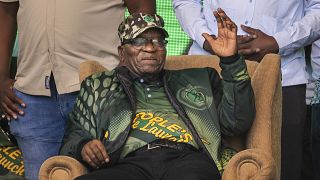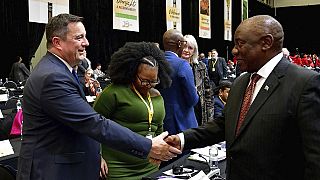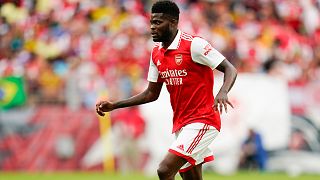South Africa
South African President Cyril Ramaphosa has included seven different parties in his Cabinet in an unprecedented power-sharing agreement in the continent's most industrialized country after the African National Congress lost its parliamentary majority in a milestone election result in late May.
Ramaphosa's announcement of the new Cabinet on Sunday night takes South Africa into uncharted political territory after 30 years of dominance by the ANC, which liberated the country from the white minority rule of apartheid in 1994 and had governed ever since.
The new multiparty Cabinet was the culmination of a month of tense and sometimes acrimonious negotiations between Ramaphosa's ANC and the Democratic Alliance, the white-led former main opposition party that has now agreed to share power with the ANC.
While the coalition is made up of 11 parties, including seven with Cabinet positions, the agreement largely rests on the ANC and the DA — the two biggest parties — putting aside their ideological differences and more than 20 years of being political foes to work together.
Here's a breakdown of the new coalition, which has the challenge of solving South Africa's deep socioeconomic problems.
ANC keeps most Cabinet positions
Ramaphosa reappointed Paul Mashatile of the ANC as his deputy president and also kept ANC officials in charge of the key ministries of finance, trade and industry, foreign affairs, defense and justice. The ANC, which won the largest share of the vote in the election with 40%, has 20 of the 32 Cabinet minister positions.
Keeping the foreign ministry under ANC leadership also is likely to mean a continuation of South Africa's overtly pro-Palestinian, anti-Israeli stance. The ANC is the driving force behind South Africa's highly sensitive case at the United Nations' top court accusing Israel of genocide in Gaza. South Africa is also set to play a significant role in foreign affairs when it takes over the presidency of the Group of 20 developed and developing nations next year.
Concessions to the DA
Ramaphosa gave the DA six ministerial positions, including making DA leader John Steenhuisen the minister of agriculture. While the DA had pushed for the trade and industry portfolio as the second biggest party, it was given deputy minister posts in trade and industry and finance, and those areas might be the sternest tests of whether the ANC and DA can work together.
The left-leaning ANC and the centrist DA are at odds over many economic policies, including the ANC's flagship Black Economic Empowerment affirmative action program that aims to advance opportunities for Black people in business. The ANC maintains it's necessary to right the wrongs of apartheid, but the DA has said it wants to scrap the policy and replace it with one in which race is not a decisive factor.
Racial connotations
The coalition faces wider challenges regarding race with the ANC, the party that liberated South Africa from white minority rule, and the DA, viewed by some as focused on the interests of the country's white minority, which accounts for 7% of the population of 62 million.
The DA has strongly denied that characterization and has support among many Black South Africans, but race remains a burning issue because of South Africa's history of brutal racial segregation under a white minority government.
Ramaphosa also made the leader of the Freedom Front Plus party part of his new Cabinet. It has its roots in former right-wing parties representing white interests, and while it has softened its stance considerably, that will be another test of whether South Africa can put race aside in the most politically diverse government it has ever had.
South Africa's third and fourth biggest parties have refused to join the coalition merely because of the inclusion of the white-led DA and Freedom Front Plus.
Steep challenges
Both Ramaphosa and Steenhuisen have committed to work together, and the DA backed Ramaphosa for a second term in a vote in Parliament last month, a major first step in their new partnership. However the coalition government faces steep challenges. While South Africa positions itself as a leading voice for its continent and for the wider developing world, that is undermined by its problems.
South Africa has some of the world's highest rates of inequality and unemployment, which officially stands at 32% across the board and a dizzying 45% for young people between the ages of 15 and 34. It also has a desperately high violent crime rate and failing public services, epitomized by rolling nationwide electricity blackouts which reached record levels in 2023.
They were all reasons why South African voters turned away from the ANC in the May 29 election.














00:59
South Africa, Austria agree to strengthen ties
Go to video
Former South African deputy president David Mabuza dies at 64
00:52
Nigeria’s Peter Obi to contest 2027 election, opposition coalition in jeopardy
01:04
South Africa: ANC partner quits key govt initiative as new spat hits coalition
01:00
Detained Chadian opposition leader Succes Masra begins hunger strike
Go to video
CAR officials issue statement claiming president is not seriously ill